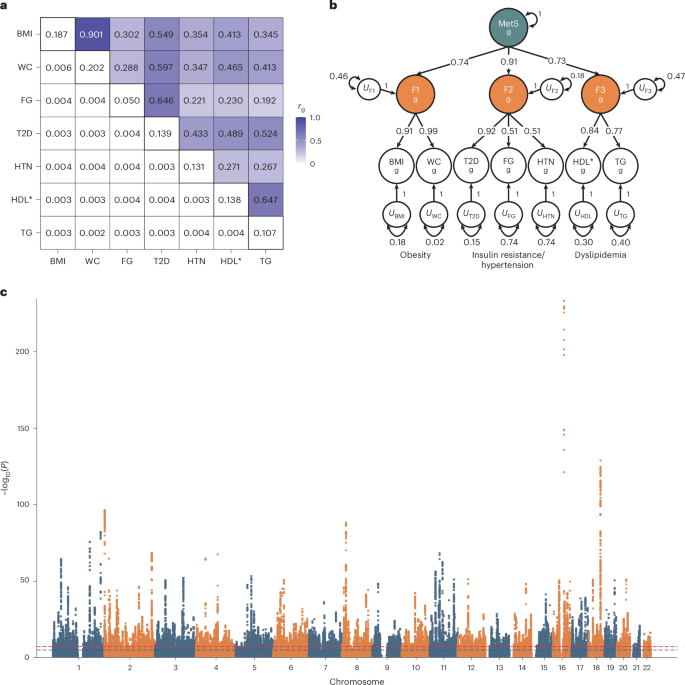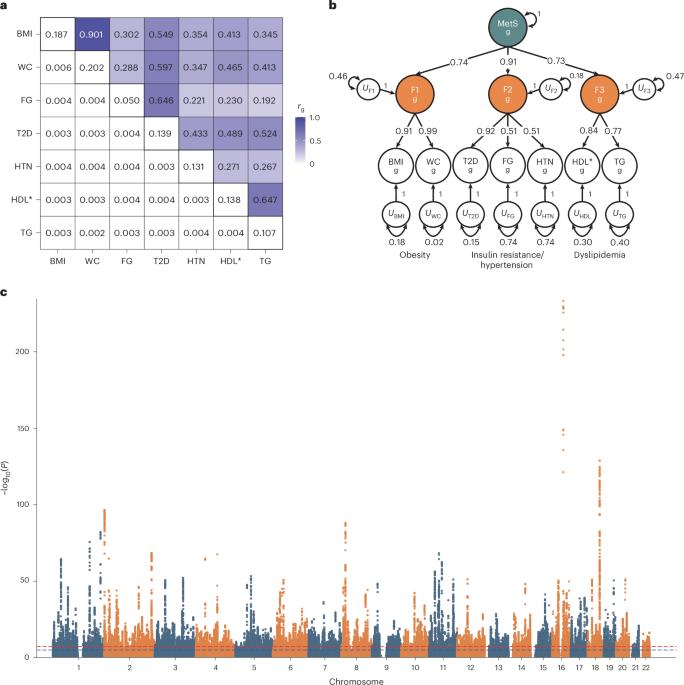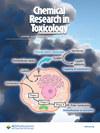对 500 万人进行的多变量基因组分析阐明了代谢综合征共有成分的基因结构
IF 3.7
3区 医学
Q2 CHEMISTRY, MEDICINAL
引用次数: 0
摘要
代谢综合征(MetS)是一种复杂的遗传病,由各种代谢特征作为风险因素组成。虽然通过大规模的全基因组关联研究,对 MetS 单个成分的遗传学进行了积极的调查,但联合遗传结构尚未完全阐明。在这里,我们利用 MetS 成分之间的遗传相关性,在欧洲开展了最大规模的 MetS 多变量全基因组关联研究(nobserved = 4,947,860)。我们确定了 1,307 个与 MetS 相关的基因位点,这些位点主要富集在脑组织中。利用转录组数据,我们确定了 11 个与 MetS 密切相关的基因。我们的全表型关联分析和孟德尔随机分析强调了 MetS 与心脏代谢疾病以外的多种疾病的关联。多基因风险评分分析表明,在欧洲和东亚人群中,MetS 的分辨能力和预测能力更强。总之,我们的研究结果将指导未来旨在阐明 MetS 遗传结构的研究。本文章由计算机程序翻译,如有差异,请以英文原文为准。


Multivariate genomic analysis of 5 million people elucidates the genetic architecture of shared components of the metabolic syndrome
Metabolic syndrome (MetS) is a complex hereditary condition comprising various metabolic traits as risk factors. Although the genetics of individual MetS components have been investigated actively through large-scale genome-wide association studies, the conjoint genetic architecture has not been fully elucidated. Here, we performed the largest multivariate genome-wide association study of MetS in Europe (nobserved = 4,947,860) by leveraging genetic correlation between MetS components. We identified 1,307 genetic loci associated with MetS that were enriched primarily in brain tissues. Using transcriptomic data, we identified 11 genes associated strongly with MetS. Our phenome-wide association and Mendelian randomization analyses highlighted associations of MetS with diverse diseases beyond cardiometabolic diseases. Polygenic risk score analysis demonstrated better discrimination of MetS and predictive power in European and East Asian populations. Altogether, our findings will guide future studies aimed at elucidating the genetic architecture of MetS. Large-scale multivariate analyses across populations of European ancestry identify risk loci for the metabolic syndrome, improving polygenic prediction models and highlighting associations with diverse traits beyond cardiometabolic diseases.
求助全文
通过发布文献求助,成功后即可免费获取论文全文。
去求助
来源期刊
CiteScore
7.90
自引率
7.30%
发文量
215
审稿时长
3.5 months
期刊介绍:
Chemical Research in Toxicology publishes Articles, Rapid Reports, Chemical Profiles, Reviews, Perspectives, Letters to the Editor, and ToxWatch on a wide range of topics in Toxicology that inform a chemical and molecular understanding and capacity to predict biological outcomes on the basis of structures and processes. The overarching goal of activities reported in the Journal are to provide knowledge and innovative approaches needed to promote intelligent solutions for human safety and ecosystem preservation. The journal emphasizes insight concerning mechanisms of toxicity over phenomenological observations. It upholds rigorous chemical, physical and mathematical standards for characterization and application of modern techniques.

 求助内容:
求助内容: 应助结果提醒方式:
应助结果提醒方式:


